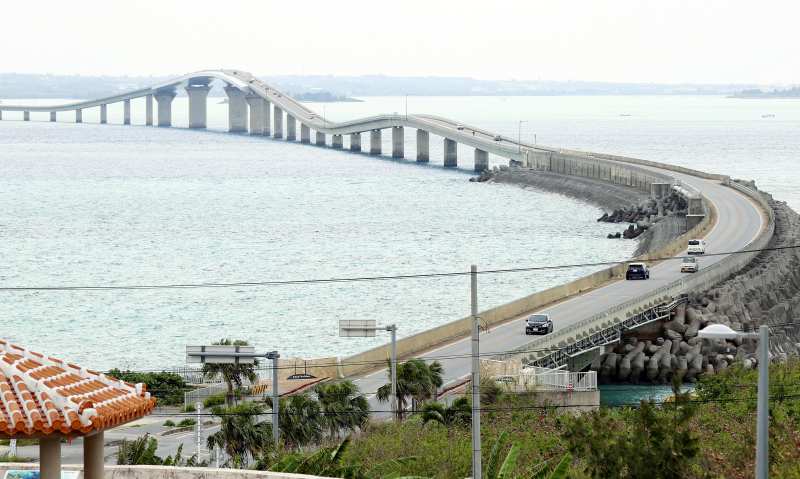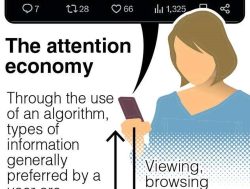50 years since Okinawa’s return: Issues hindering self-reliance 2 / Tourist-vitalized islands thrive, though not everybody is happy

The Irabu Bridge in Miyakojima, Okinawa Prefecture, connects the island of Miyako, seen in the background, and Irabu Island.
The Yomiuri Shimbun
13:48 JST, May 3, 2022
Since reverting to Japan on May 15, 1972, Okinawa Prefecture has become a major tourist destination. However, work remains to improve its economic self-sufficiency and standards of living. This series examines such efforts.
◇
The Irabu Bridge connecting the islands of Miyako and Irabu in Miyakojima, Okinawa Prefecture, opened in 2015. The 3,540-meter-long structure is the largest toll-free bridge in Japan.
“[After the bridge opened] our sales tripled and the area’s specialty, Shio Chinsuko cookies, disappeared from the shelves,” recalled a women who works in a nearby souvenir shop.
In fiscal 2018, visitors to Miyakojima doubled in number to more than 1 million a year. But tourism has transformed the tranquil landscape of sugar cane fields, and the lives of the city’s residents.
A hotel funded by a mainland Japan-based company is currently being constructed in the Sawada district of Irabu Island. The Miyakojima municipal government’s city landscape ordinance restricts beachfront buildings to two stories, but city officials nonetheless green-lighted the four-story hotel, saying the building takes the surrounding scenery into consideration.
“A building of that height will block the view of the sunset,” said 64-year-old Mitsunori Kawamitsu, who heads a local neighborhood association. “Even though the area is developing economically, we’re losing precious things inherited from our ancestors.”
A separate villa-type hotel recently started operating in the district, and most of the land near the beach has been snapped up. Land prices in the city have risen and the average monthly rent for a single-room apartment — previously around ¥ 30,000 to ¥40,000 — soared to as much as ¥100,000 at one point.
In some cases, apartment landlords and tenants have fallen into dispute because landlords have tried to raise the rent. “Even though tourist numbers have gone up, the prefecture’s wage levels haven’t changed,” said a local resident in his 50s. “If things go on like this, it will become impossible for locals to keep living in this island.”
Prior to being returned to Japan in 1972, Okinawa operated under U.S. stewardship. As cheap foreign products were readily available in the prefecture, the region never developed a manufacturing industry. Rather, it was the tourism industry that drove the local economy.
While under U.S. control, the prefecture ran “Battle of Okinawa memorial trips” to attract tourists from mainland Japan. In 1975, three years after Washington relinquished control of the islands, the Okinawa International Ocean Exposition was held: The event triggered land acquisition in the west coast and other parts of Okinawa’s main island, as well as the opening of a number of hotels operated by companies on mainland Japan. In fiscal 2018, more than 10 million tourists visited Okinawa Prefecture, putting it on a par with resort islands such as Hawaii in the United States.
However, some say that tourism-focused development has stripped the prefecture of its unique charms. In a survey conducted by the prefectural government in fiscal 2020, tourists flagged the “beautiful ocean,” and the “landscapes” as their favorite things about the area.
But the reality is, areas in more than 300 locations — each measuring at least 1 hectare — have been reclaimed. Shallow waters with coral reefs have been replaced by hotels and commercial facilities. As a result, the prefecture’s size has expanded by some 3,800 hectares, roughly equivalent to 800 Tokyo Domes.
Some people have begun to seek ways to balance tourism and the traditional Okinawan way of life.
Each year, about 500,000 tourists visit Taketomi Island, roughly 400 kilometers southwest of the Okinawa’s main island. The island’s population of about 350 residents continue to carry out traditional rituals and ceremonies while living in houses with red-tiled roofs. Tourists traverse the island in water buffalo-pulled carriages.
There have been some attempts by outside companies to develop Taketomi Island as well. Now, residents are working toward buying back areas of land. To fund the initiative, locals ask tourists for a ¥300 “entrance fee” at the ferry terminal and other locations. The donation is purely voluntary, and those who opt to pay receive gifts such as island vegetable seeds.
“Tourism is important, but if it goes too far, the island’s culture, nature and charms might be lost,” said Shosei Uchimori, the 62-year-old director of a local community hall, which is a self-governing body on the island. “We want to keep living here while upholding the spirit of the island.”
Popular Articles
Popular articles in the past 24 hours
-

Japan Prime Minister Meets With Anime, Music Experts to Discuss D...
-

70% of School Institutions in Japan Fail to Check New Database on...
-

In the Italian Alps in a Region That Will Host the 2026 Winter Ol...
-

Sumo Scene / 2 New Yokozuna Make 2025 a Year of Great Upheaval, 2...
-

U.S. Hoping to Use Heavy Weapons in Training at 5 GSDF Sites
-

Shrine Maidens Assemble Treasure Ships Ahead of New Year's Pilgri...
-

New Keizai Doyukai Chairperson: Heavy Responsibility to Rebuild O...
-

Santa Claus appears at Chubu Centrair International Airport
Popular articles in the past week
-

U.S. Senate Resolution Backs Japan, Condemns China's Pressure
-

Japan Set to Participate in EU's R&D Framework, Aims to Boost Coo...
-

As Chinese Tourists Shun Japan, Hotels and Stores Suffer
-

Bus Bound for Hokkaido's New Chitose Airport Catches Fire Wednesd...
-

AI Personalizes Foreign Language Lessons in Pilot Projects, Inspi...
-

Rakuten Develops New Large Language Model; ‘Rakuten AI 3.0’ Is On...
-

Popularity of Piggy Banks Across Time and Place Seen at Bank's Mu...
-

Nagano Pref. Village to Introduce Fines for Some Disruptive Behav...
Popular articles in the past month
-

Tokyo Economic Security Forum to Hold Inaugural Meeting Amid Tens...
-

Keidanren Chairman Yoshinobu Tsutsui Visits Kashiwazaki-Kariwa Nu...
-

Imports of Rare Earths from China Facing Delays, May Be Caused by...
-

University of Tokyo Professor Discusses Japanese Economic Securit...
-

Japan Pulls out of Vietnam Nuclear Project, Complicating Hanoi's ...
-

Govt Aims to Expand NISA Program Lineup, Abolish Age Restriction
-

Blanket Eel Trade Restrictions Rejected
-

Key Japan Labor Group to Seek Pay Scale Hike
"Society" POPULAR ARTICLE
-

M4.9 Earthquake Hits Tokyo, Neighboring Prefectures
-

Israeli Tourists Refused Accommodation at Hotel in Japan’s Nagano Pref., Prompting Protest by Israeli Embassy and Probe by Prefecture
-

M7.5 Earthquake Hits Northern Japan; Tsunami Waves Observed in Hokkaido, Aomori and Iwate Prefectures
-

Tsukiji Market Urges Tourists to Avoid Visiting in Year-End
-

High School in Kyoto Says Students Shoplifted during Recent School Trip to Bali, Indonesia
JN ACCESS RANKING
-

Tokyo Economic Security Forum to Hold Inaugural Meeting Amid Tense Global Environment
-

Keidanren Chairman Yoshinobu Tsutsui Visits Kashiwazaki-Kariwa Nuclear Power Plant; Inspects New Emergency Safety System
-

Imports of Rare Earths from China Facing Delays, May Be Caused by Deterioration of Japan-China Relations
-

University of Tokyo Professor Discusses Japanese Economic Security in Interview Ahead of Forum
-

Japan Pulls out of Vietnam Nuclear Project, Complicating Hanoi’s Power Plans






